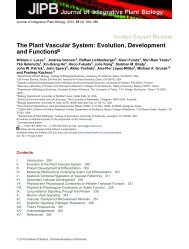A Chloroplast DNA Phylogeny of Solanum Section Lasiocarpa
A Chloroplast DNA Phylogeny of Solanum Section Lasiocarpa
A Chloroplast DNA Phylogeny of Solanum Section Lasiocarpa
Create successful ePaper yourself
Turn your PDF publications into a flip-book with our unique Google optimized e-Paper software.
184 SYSTEMATIC BOTANY<br />
[Volume 29<br />
FIG. 3. 50% majority rule consensus tree from the aligned data set with indels excluded and coded indels included (Analysis<br />
3). Dashed lines are branches that collapse in the strict consensus tree. Bootstrap values (500 replicates) included on the branches.<br />
Arrows mark Asian species <strong>of</strong> section <strong>Lasiocarpa</strong>; all other members <strong>of</strong> the section are New World taxa.<br />
characters by Whalen et al. (1981) and Whalen and<br />
Caruso (1983) showed S. hirtum to belong to a clade<br />
including S. lasiocarpum, S. candidum, S. quitoense, and<br />
S. pseudolulo, and this relationship was recovered in a<br />
subset <strong>of</strong> the analyses <strong>of</strong> Bruneau et al. (1995) based<br />
on morphological and isozyme characters and chloroplast<br />
<strong>DNA</strong> restriction sites. <strong>Solanum</strong> hirtum hybridizes<br />
with S. quitoense (easily), with S. stramonifolium (with<br />
moderate success), and with S. pseudolulo (with difculty)<br />
in greenhouse crossing trials (Heiser 1972, 1989),<br />
but no successful intraspecic crosses were obtained<br />
between accessions <strong>of</strong> S. hirtum from Trinidad and<br />
Costa Rica (Heiser 1972). Results from the trn data indicate<br />
that the sequences <strong>of</strong> the two accessions <strong>of</strong> S.<br />
hirtum (from Costa Rica and Ecuador) are very similar<br />
and that S. hirtum forms an isolated basal branch in
















